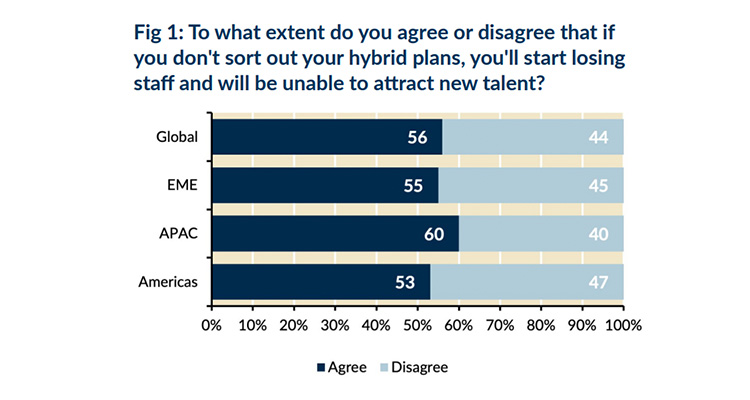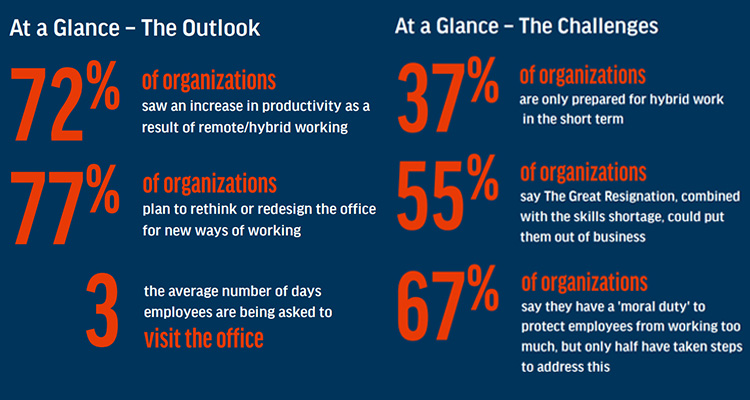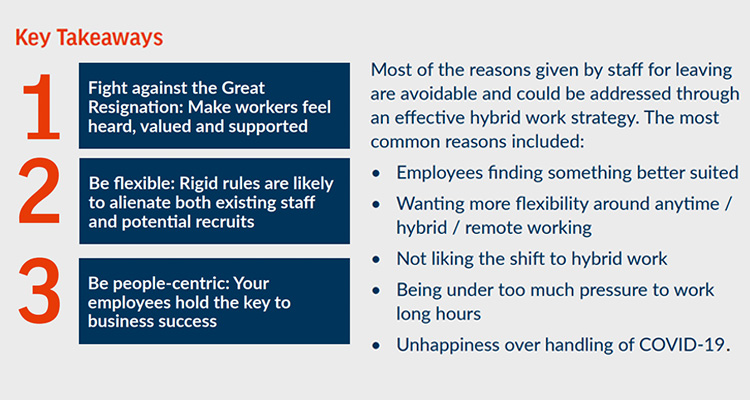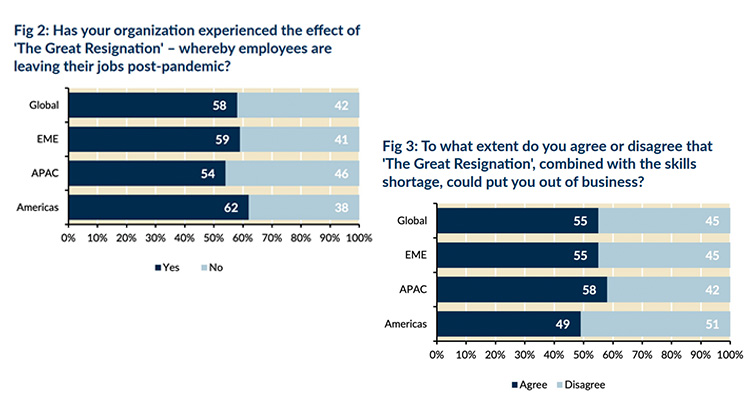No Hybrid, No Work: My Take on Poly’s Employment Retention Study
 Poly sent a new report that examines how organizations are responding to employees’ demand for the “ideal space to work from.” The report analyzed data taken on work policies, culture and wellness from over 2,500 global business decision-makers. Titled “Recruit, Retain and Regrow,” the study indicates that organizations who want to succeed must address their work processes, plans and environments. Otherwise, recruitment and retention rates “will be at risk.”
Poly sent a new report that examines how organizations are responding to employees’ demand for the “ideal space to work from.” The report analyzed data taken on work policies, culture and wellness from over 2,500 global business decision-makers. Titled “Recruit, Retain and Regrow,” the study indicates that organizations who want to succeed must address their work processes, plans and environments. Otherwise, recruitment and retention rates “will be at risk.”
When Poly sent this information, I found myself asking a lot of questions. I am a young professional who graduated from college during the pandemic. The “hybrid WFH lifestyle” is so standard to me now that I can’t imagine a workforce without it. But, how does that pair with what the future of the workplace will look like? Is it as simple as creating a hybrid environment and your employees will immediately be happy? I don’t believe so. I won’t discuss what makes a good hybrid workplace in this piece, but I will give my thoughts on what the study alludes to. Let’s look into the data and see!
The Overview
“At Poly, we believe that being able to enable a hybrid working environment is not the endgame, but a starting point for the competitive organizations today,” said John Goodwin, senior vice president of public affairs at Poly.
As I mentioned earlier, we’ve all grown used to hybrid work. We know the buzzwords and lingo the pandemic so lovingly instilled in us over the past few years. Words and phrases like “WFH,” “hybrid meetings,” “Let’s jump on a Zoom” and more are used daily. But this is now the baseline. Poly’s research indicates that companies who are working to offer flexibility in the workspace, such as harboring a hybrid environment or making adjustments to their office spaces, are the companies that employees are supportive of (and staying at). What does this mean for the companies who are not?
The Sweet Taste of Hybrid Work
Here’s the breakdown of some of Poly’s research:
- 56% of all organizations believe that if they don’t address their hybrid work processes and plans, they’ll start to lose staff and will be unable to attract new talent.
- Globally, 58% of organizations are seeing a greater turnover in staff since the start of the pandemic.

People are leaving their organizations, and employers are starting to understand why. When asked why they left, employees (16%) expressed that they did not get their desired hybrid flexibility scheduled and that they were unhappy about the way their employers handled COVID-19 (9%). While these may seem disconnected, I can understand why this would encourage employees to leave their workplaces. Firstly, especially for the younger (millennial) population of the workforce, we’ve always lived hybrid lives. We have online presences and we can easily separate them from work and play. To be asked to sit at a desk 40 hours a week with masks on our faces while we watch the clock is just simply not how the workforce works anymore. Creating a hybrid space where you can come and go as you please (as long as you get your work done) makes us feel respected and driven. Secondly, there’s this thing called COVID-19, and though we’re tired of it, it’s still a threat. If an employee cannot trust their employer to address the virus and put policies into place to make them feel safe, they won’t want to go into an office, even part-time. They won’t want to work for that company at all.
This data doesn’t just focus on the younger workforce, though. Poly found that 72% of surveyed companies saw an increase in productivity as a result of the shift to hybrid work, with a global average increase of 27%. This isn’t just us youngins, is it? When something like a pandemic hits, you have to take advantage of the positives you can find. Mentally, many people found relief in not having to go into an office because of safety, grief or fear of the virus. Plus, you have to admit it’s easier to jump on a Zoom call in pajama bottoms with a hot pot of coffee five feet away. Before COVID-19, I doubt many companies would have considered remote or even hybrid work. The fact that Poly’s study highlights this productivity increase speaks volumes to the pros of hybrid work — and in what people desire.
Poly’s research also cites something called “The Great Resignation.” Termed by professor Anthony Klotz, this trend references the rise in employees who are leaving their jobs since the pandemic began. 55% of organizations surveyed believe this trend threatens their ability to stay in business. I believe this in and of itself will cause companies to at least consider what they can do to keep their workforce strong and their employees happy. But the needs and desires of employees and employers don’t exactly match up.
When analyzing the pros, we must also analyze the cons. The problem here is some companies (employers) just don’t see a future in the hybrid environment. In fact, Poly found that 52% of organizations studied think hybrid work is a blip, and only 48% of them are fully prepared for a hybrid working environment. As mentioned above, 72% of surveyed companies saw an increase in productivity due to hybrid work. But, 62%, 61% and 56% of organizations in APAC, EMEA and the Americas, respectively, believe that if employees aren’t in the office, they won’t be able to build relationships and progress their careers. Even further, 24% each of the Americas and APAC employers are demanding that their employees return to the office full-time, including 17% of EMEA. What is causing the disconnect between employers and employees?
I don’t know the answer, but Poly’s study did find that employers aren’t ignoring the needs of their employees — they’re just worried about the reality of hybrid work. 74% of employers are concerned that remote working has made fostering and retaining work culture harder than ever, but that doesn’t make them blind to the needs of their employees. 80% of employers believe employees should have the right to request a flexible work schedule from day one. 49% of employers are also worried that there is an unhealthy culture of overworking. It seems as though employers need to find a way to tackle the fear of losing work culture and productivity and create an environment where employees want to work. Can employees and employers meet in the middle?
Perhaps. Poly found that 84% of employees are being given rules on the number of days they are required to be in the office. Could this be adjusted based on an employee’s comfort level? Define office. Does the office have to be one central space? I think rules like these will have to vary from company to company, person to person and employee to employee. I also think that creating a hybrid environment where everyone feels that they can have their needs met will alleviate a lot of stress for both employer and worker, but building a fully remote or hybrid work environment takes time. Does a company simply downsize and restructure, or should they rebuild under an entirely hybrid model?
 To Rebuild or to Restructure?
To Rebuild or to Restructure?
There will be pros and cons to rebuilding or restructuring, but 22% of employers believe that “employees are in offices sporadically, so downsizing spaces is the next step.” 64% of companies see technology and experiences as the face of a company rather than the physical office space. Poly’s study reads, “Expanding the quotient of spaces available rather than the definition as to whether the space is virtual, offsite, remote or hybrid, will help employers develop a robust hybrid work strategy.” I couldn’t agree with this more. I think this indicates a move towards a remote or hybrid workforce, one that focuses on products and people rather than the office they sit in. The key to this is preparing for it.
The good news is, companies are preparing for this change. Poly says equality and experience will be the focus points of the next ideal workspace. 92% of companies are investing in both software and devices and cloud-based applications with collaboration software. 89% of companies are investing in headsets, 86% in cameras and 83% in speakerphones. All of these solutions will help equalize the hybrid workspace for employees and provide a better experience as they transition. What’s more, Poly found that 77% of companies are redesigning their office with more open plan areas, collaboration spaces, socialization areas, quiet zones and more. This again highlights that companies want to succeed and provide employees with what they want — it’s all about finding a flexible solution that offers a hybrid environment that fosters a productive workflow.
 If you want my final thought on what this data means, I think the solution can be solved with one word: flexibility. Flexibility is the respectful, hopeful and adjustable (which is key) solution that will meet both employee and employer needs. There will be employees who want to work full time in an office. There will also be employees who want to work full time from home. As Poly’s study found, it is up to employers to invest in, plan for and start creating a hybrid, flexible workspace that is more than just a physical office. I think we need to start thinking about the word “workspace” as less of a tangible location and more of a connected, hybrid “world” that houses a company. But that’s just my take.
If you want my final thought on what this data means, I think the solution can be solved with one word: flexibility. Flexibility is the respectful, hopeful and adjustable (which is key) solution that will meet both employee and employer needs. There will be employees who want to work full time in an office. There will also be employees who want to work full time from home. As Poly’s study found, it is up to employers to invest in, plan for and start creating a hybrid, flexible workspace that is more than just a physical office. I think we need to start thinking about the word “workspace” as less of a tangible location and more of a connected, hybrid “world” that houses a company. But that’s just my take.
Find the full study here. Read the study on Poly’s website here.






